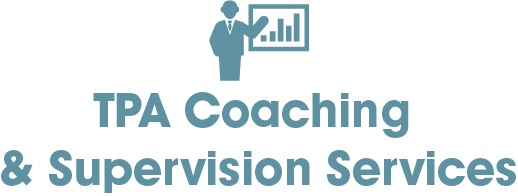The Benefits of Calculating the ROI of learning:
- by Tim Anderson
- •
- 27 Mar, 2019
- •
The Holy Grail or a missed opportunity?

For many years now I have read about the desire to be able to demonstrate value for money in corporate training and development. Type ROI for training into any search engine and you can find hundreds, if not thousands of educated opinions on the subject.
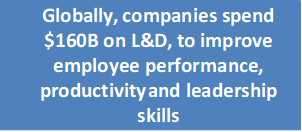
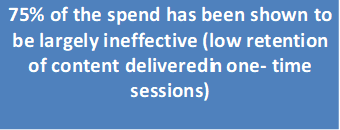
And yet despite these depressing statistics, according to Deloitte Human Capital in a report in 2016, 84% of senior leaders believed leadership and development investment is vital for the success of their organisations.
So, off the back of the fact that of $160 B spent almost $120 B is ineffective and that 84% of leaders still believe that investment in L&D is vital, I make no excuse for now publishing my own thoughts among the thousands already out there.
What I would like to offer however is my thoughts on why we measure on not just what we measure. I will then offer some alternative ideas on what we can do to ensure the information we gather from a fresh approach to measurement can help influence how we support our learners to become the best they possibly can.
If you take a look at both of my web sites http://www.salesimprovementservices.com/ and http://tpacoaching.co.uk you will see that I have long been an advocate of the benefit of measuring training and development and I have further advocated we do so on the basis of organisational impact.
This is only fair, as the organisation is investing in its people and has a vested interest in their team members specific development which should be aligned to organisational objectives.
A private company will be responsible to its shareholders and a not for profit or government agency will be responsible for maximising the efficiency of funds made available for its cause.
The intervention measurement is generally made against four potential categories for impact:
• Quantity; How many, more or less
• Quality; How much better
• Cost; How much, more or less
• Time;
How much, longer or shorter = increased margins.
I visualise this as such an input, change and output process:
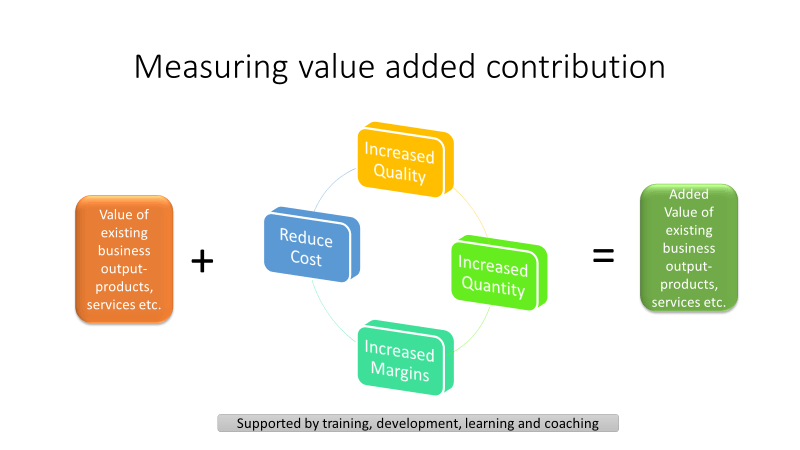
This process should be supported by training and coaching interventions to help embed the development and change required.
These are reasonable expectations for any organisation to expect from an investment in training. Expressed in a classic input, output diagram we can start to measure contribution improvements against at least one of the key categories. If we measure these against SMART objectives and against a curriculum or intervention, an organisation might be able to gather enough data to at least justify the spend.
My question however is what are we missing by restricting the measurement purely to output?
What other benefits might an organisation want to acquire from investing in its workforce?
What else should we consider if such measurements are to
provide us with better data to help improve the ROI and to address the rather
depressing estimate that 75% of spend is ineffective?
Let’s consider the human element of development.
The human element around training and development is of course central to the conundrum, if we do not employ people, we do not need training. But if we do, then we surely have a need to develop our workforce if we want our organisations to thrive.
84% of leaders still believe this is vital.
I will consider the human aspect of this challenge from two
perspectives, firstly the organisations people strategy and then from the
perspective of the employee or learner. Both have an important influence on
what we might need to measure.
Before I get into these two aspects, I would like to share some thoughts on measurement from Bernard Marr, author of several books on big data, using key performance indicators and on measurement. In his book Managing and Delivering Performance, Marr outlined why we measure and suggests that we measure for three reasons:
1. Because we don’t trust people to be able to carry out their functions.
2. Because we must; due to compliance drivers.
3. To provide feedback to help develop learning and empowerment.
It is the latter where we should focus our attention if we want to support our team toward organisational and personal development. It is from the latter I also base my opinion around.
The use of data derived from measurement and provided as feedback should extend to support the employee not just in their current roles, but also their future roles within your organisation and perhaps beyond. Providing feedback to help the learner develop is fundamental in the success of an organisational people strategy and for individual development.
From the business perspective
How the organisation has developed its people strategy there are several elements to consider. A full review of the PESTLE environment might influence your HR policy to address things such as:
· What is the political situation of the region where you operate and how can it affect the recruitment and retention of staff?
· What are the prevalent economic factors, is it an employer’s market or an employee’s market and how does this effect salary structures?
· How much importance does culture have in the region and what are its determinants?
· What technological innovations are likely to pop up and affect the development needs of the team?
· Are there any current legislation that regulate the industry or region, or can there be any change in the legislation's that might affect you?
· What are the environmental concerns for the organisation, can a people focused strategy change negative perceptions of your industry or your organisation?
Other specific things to accommodate might include:
Raising employee productivity: Increase staff loyalty to the company; Develop more flexible employees; Improve staff morale; Develop core skills; Improve quality of company products/ services; Improve company image; Change behaviours or culture.
Our measurement should include how the organisation and its learning and development philosophy is shaped from the data collected.
A Case study.
In a recent coaching intervention, I have been supporting a senior manager in a global B2C organisation. The organisation has purposely implemented a strategy in my client’s local region to recruit new graduates with less experience and who might demand less salary than a more experienced person. This strategy helps the organisation to differentiate an employee offering that might look attractive to someone new into the workplace. With an international reputation for developing its people and benefiting from size and longevity, it can offer graduates secure employment, an excellent development path into more senior management and variety in terms of functions and career progression.
Off set against this is an employee’s market place where quite often smaller firms are paying as much as 20% more for similar roles. The attraction of a quality development programme and an opportunity to gain a broader experience can sound attractive to a new graduate into the work environment.
Measurement of success is not purely on output, although this is still important, but includes staff retention levels, employee satisfaction, accreditation and effective internal recruitment numbers versus recruiting from outside of the company.
Our coaching work has been around helping the senior leader consider methods of retention and interventions to ensure the team stay engaged and motivated and retain their enthusiasm for further development.
The intervention has helped the organisation engage effectively with millennial's in their region and help maintain their international reputation as an attractive employer to work for.
For my coachee, measurement of purely output would have
missed some important, none direct business drivers that have been able to
influence an overall approach to people management.
With Generation X now becoming the majority of the workforce and with Generation Z entering employment for the first time, it is important to consider how an organisation might need to alter how it measures success and how it might support staff that are operating in what is termed as a VUCA world, (volatile, uncertain, complex, and ambiguous).
An interesting statistic from Gallup in 2018 stated that “87% of millennial's are seeking professional development more than any other benefit”. How can an organisation use this statistic to help promote and advance its training and development offering?
Changes in culture, values and world events provide suitable reasons why an organisation might want to measure success differently and this will in turn help the organisations forge enhanced and more appropriate development programmes to support their employees.
And what about the employees themselves?
From the employee perspective

According to Bain & Co, one of the world's leading management consulting firms: “most leadership development programs aren’t up to the job of working with individuals on capabilities that many feel are nebulous, overly personal or hard to assess. More inspirational skills are exactly what today’s environment requires.”
A one size fits all approach is essentially a cop out.
Traditional training methods often rely heavily on a single ‘expert’ disseminating information. This can be problematic as many training courses are heavily didactic – the information contained in an ‘off the shelf’ adult learning package might not be applicable to everyone in their real-world employment. Once the session is over and the expert has gone, there is nobody to whom questions can be directed and the learning exists entirely in a temporary bubble.
Researchers looking at productivity, leadership and development have made an interesting discovery which supports social learning theory and brings into question previous training methodologies. Anyone who has begun working for a new company will know that after the initial induction period, most ‘on the job’ knowledge is gained from asking colleagues and those around you.
Research has shown that regardless of what position you’re taking in a company, you will learn around 10% from formal training in your induction and the remaining 90% via your direct experience and expertise shared by colleagues. The 70:20:10 model was developed across the 1980s and 1990s by Morgan McCall.
The model splits our understanding of the learning process into three separate sections, noting that 70% of our learning comes from our direct experiences, 20% comes from our social interactions with others and the remaining 10% comes from formal training.
Management development teams are beginning to understand the powerful combination of the 70:20:10 model. Traditional training methods may have had their day. Our brains have been bolstered by ever more sophisticated technology, and this combination is creating a new, innovative and exciting world for adult learning across the globe.
This is even more evidence to suggest we need to take a fresh approach to training and development methods and therefore an alternative approach to how we measure the value of such interventions too.
I would like to consider for a moment the motivation factor and how this might affect training and development and its measurement. If an employee is not motivated to learn, the intervention will be less successful than if the learner was fully on board. A disinterested learner will have a negative effect if we just measure the intervention against output or organisational objectives.
Impact can be measured on output but the need of the learner and the preference for them to take ownership of their own development is also an important factor to consider. Without motivation and drive from the learner, and only data collected on output, we may decide to amend what was a good intervention due to the wrong reason and floored feedback.
I recently took part in a development programme that was based on the thoughts and theories of Fred Kofman, from his book Conscious Business. During his introduction to the programme he suggested that the greatest impact of a training programme might come from the decision to have enrolled on the programme in the first place.
As an analogy, he shared a story of how a group of researches decided to review the benefit of patient participation in shorter term therapy compared to a more traditional long-term psychoanalysis intervention.
He mentioned how they had tried to measure impact of long-term support against a short-term programme consisting of 8 session. The analysts discovered that 90% of the benefit for the patient had been derived sometime within the shorter term 8 session intervention which impacted just as much as the longer-term intervention.
They then decided to extend the research and investigate the impact over four sessions (halving the intervention duration), amazingly they discovered that 90% of the patient benefit had been derived from the first four sessions. They then took the analysis down to 2 sessions and eventually one session and, once again they found that 90% of the benefit had already been achieved after one session. Being analysts, they could not help but review what might happen with no therapy and they found that again 90% had been gained prior to the formal therapy being started. The conclusion was made that perhaps the greatest impact a patient gains from a therapeutic intervention is gained from their decision to enter therapy in the first place.
I have experienced a similar scenario when a few years ago I gave up smoking. The biggest impact I believe was my genuine desire to quit and was only supported by things such as nicotine patches and e- cigarettes. The biggest shift and the reason for my success of quitting came from my desire to quit rather than the methods I used to sustain my abstinence.
I wonder if the same is true for
many development interventions? If so, we might benefit from altering our
measurement. At the very least we should include a more rounded approach to
measuring intervention that takes into consideration the state of mind and
motivation when a learner embarks on a programme of development.
Another interesting theory was shared recently in a response to a training query I read on measuring return on investment for coaching.
Whilst John used this analogy to provide some interesting feedback around measuring impact of coaching interventions, this does have a parallel to the effect on most training and development interventions. What was the catalyst that stimulated the change in behaviour? How can we identify this and how do we measure it?
We are in danger of spending a lot of time, effort and money on measuring the wrong things.
Referring to Fred Kofman again and my recent development programme, whilst I listened to the introduction to his training intervention, he suggested that teaching is pointless. He suggested he could teach the participants very little, all he could do as a trainer was facilitate the participants own learning. It was up to me (and the other participants) to establish how we might learn and how we might then use the information that we had shared from our session.
This would indicate that for training and development to be effective it needs to be taken by people that have already made the decision that they have a gap, being a position from where they are, to where they want to be. They should already have committed mentally to find information and methods to help them bridge the gap.
I like to include the Kirkpatrick model in my own assessments. This is of significance because it asks four key questions to determine if the intervention has been successful and considers the learners journey as well as the organisational requirements. It measures the following:
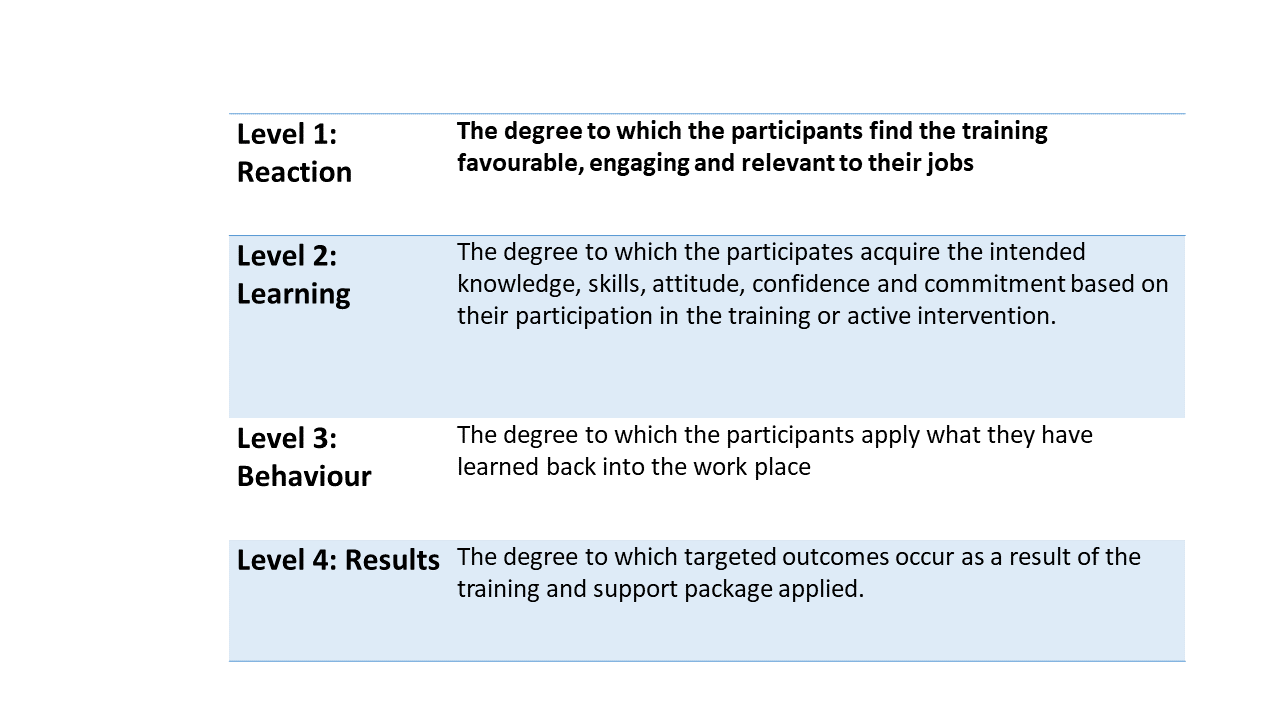
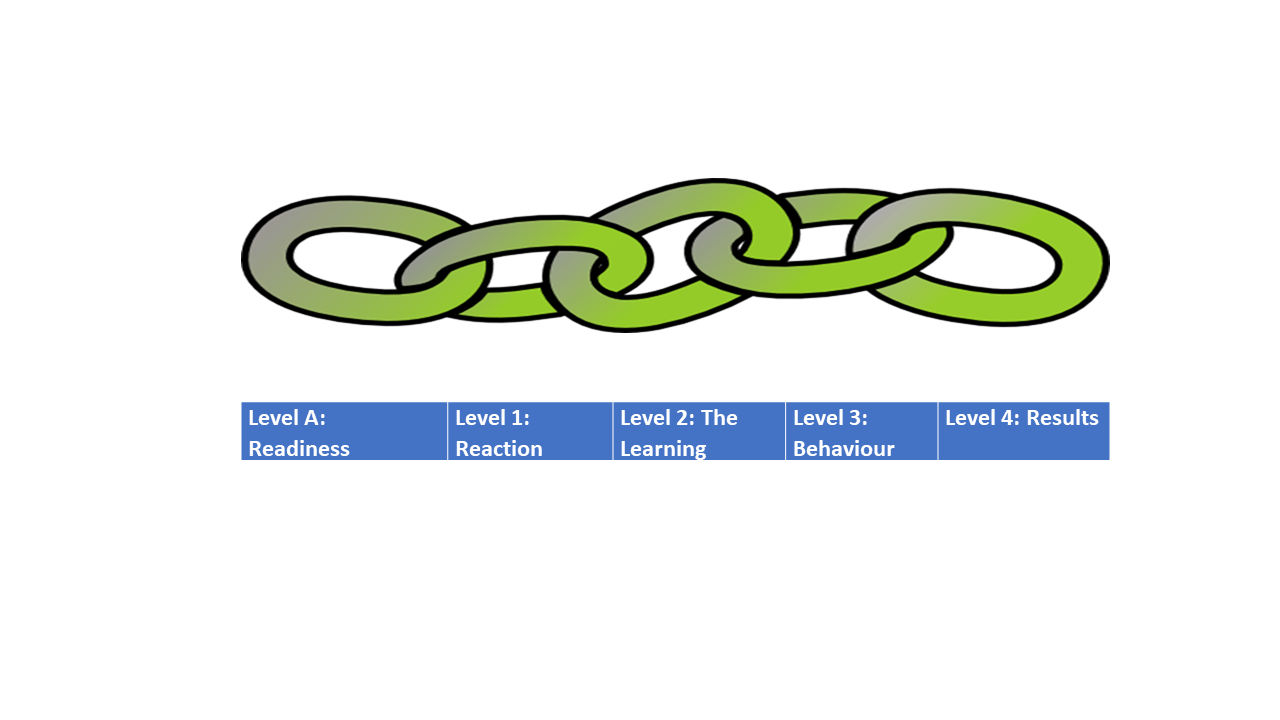
I believe this five-phase approach to measurement would add depth and quality to the organisational drivers of Quantity, Quality, Cost & Time.
It will help us to share great evidence with senior stakeholders on value for money for the individual, the organisation and the effectiveness of the processes being used to accommodate and support the training and development.
It can help us measure training and development with greater depth and clarity.
In Conclusion
Fred Kofman described the Three Dimensions of Business in his book Conscious Business. He suggests that every organisation has three dimensions: the impersonal, the task or the It; It has an interpersonal element which includes the relationship or the WE and finally it has the personal element, the self or the I. This is a fascinating concept and one I strongly recommend you research but considering the IT, WE and I in terms of measuring the effectiveness of training and development we can apply this to measuring:
The IT = The process or method of delivery.
The WE= The benefit to the learner, the organisation and the wider stakeholders
The I= the skills, ability and the desire of the individual to take ownership of their own learning journey.
I think it is time we reassessed how we measure the ROI for training and development so we can take a wider and deeper review of the effectiveness of the investment and hopefully move the 75% failure rate to one that delivers greater satisfaction to the organisation and the learner.
We need to consider measurement and use of the data collected to review the learner, the organisational benefits and the development process.
I would be interested to learn of your perspectives to this article. All comments are gratefully received.
In my next article I will share some thoughts on how coaching can add value to all developmental programmes.

In these challenging times I would like to share some thoughts with you why being people focused will have longer term benefits once we move out of lock down and toward more favourable times.
The term of the month seems to be furlough and I understand the need for businesses of all shapes and sizes to take whatever steps they need to take in order to survive however we would urge all organisations that have needed to take these measures not to fall into the trap of “out of sight out of mind”.
Never before have we had an opportunity as business owners and organisational leaders and managers to show that our people focused cultures are indeed what we do and how we act. I wonder how we might meet this challenge.
Taken from an excellent guide from the Chartered Institute of Personnel and Development ( CIPD) to an explanation on the rules and regulations around furloughed workers here we can provide a brief explanation furloughed working regulations.

I wanted to share a coaching session I provided to a client recently who brought to their coaching session a topic on how to support them in an up and coming bi-annual performance review. It was an interesting use of a coaching session and it got me thinking, why do we still carry out performance and staff reviews in methods created in the last century?
Employees the world over have been subject to the annual appraisal for as long as I can remember, I think I attended my first one back in the late 1970’s, I am not sure they have moved on much since then!
Back to my coaching session though. The coachee had suggested we look at areas such as how she could communicate a rich and powerful story that could describe many of the great things she had achieved since her last review and which were not captured by the standard KPI’s that everyone was measured against in the organisation. She wanted to include feedback on the things she had done since she had been promoted late last year, so her manager was aware of her growth. And she wanted to widen the theme, so the conversation did not major on merely what she had done this past month or so.
My client wanted to explore with me how to make less visible things visible; she wanted to include items such as being a team player, being seen as trustworthy by her staff, showing up to work with the best version of herself on offer and how this delivered on her being considerate and respectful of the team members. What she was eluding to was how to get the strengths in soft skills onto the agenda?
All too often the agenda that is set for the review is to meet the needs of the manager and that of the organisation, ticking off an event in the calendar and ensuring that key business drivers are being met. This is fair but also one sided and whilst it might support short term deliverables the business needs, it does not address the team members own career aspirations very well, neither does it address some of the harder challenges facing many organisations today in terms of recruiting, retaining and developing their workforce for the 21st Century challenges they face.
Two or three other areas we considered exploring were around the review process itself and how we might be able to keep key things top of mind continuously and not just at review time. How best to do this?
We considered the difference between performance reviews and development reviews? How can the attendee ensure both performance (an historic measure) and developmental conversations (taking a future perspective) take place within the meeting? We considered how to raise awareness of how the softer challenges were important in terms of reaching the organisational goals.
I was impressed with the approach my coachee had taken to preparing for the forthcoming meeting and that she had considered bringing this topic to coaching, she also mentioned how she had talked with her peers which in turn had added to the depth of information she was using to be able to best plan and approach the meeting. Clearly there was some deep thought from my client around how best to take advantage of the forth coming review. She acknowledged and accepted that the three key areas her company measured would need to be addressed but she wanted this to be a two-way process.
On reflection of the session I considered several things, firstly I wonder how well her manager was preparing for this meeting? I have had several coaching sessions with senior managers who have shared with me that whilst they always intend to approach the annual reviews with a greater level of planning, by the time review season hits, other dynamics have taken preference to the allocated planning time and so they end up with more of the same as last year.
I also considered the power of regular reviews; these are opportunities to learn and plan for both the manager and their employees. I am reminded of Bernard Marr description of why we measure from his fantastic book Managing and Delivering Performance ( p141) where he suggests we measure for three reasons, firstly because we do not trust our team will perform ( pretty negative), secondly because we have to (compliance) or thirdly, because we want to provide rich information that can help us improve. Of course, we all aspire to the third of Marr’s reasons, but I wonder how well we manage the review process as managers and how rich and varied is the quality of the data we use when carrying out such reviews?
It occurred to me too that most organisations offer reviews as a type of snapshot. There is nothing wrong with this in theory, and an annual review is better than no review at all. I noticed my client’s company were carrying out reviews twice a year and I know other organisations where I coach that do so each quarter. Each organisation uses a variety of tools to collect data that can be used during the review such as 360% surveys, performance impact data on internal and external customer satisfaction, team retention. But generally, this data is also provided as a snapshot. And yet, with the advances in technology and data integration it must be feasible to provide accurate and up to date information that each employee can use on a weekly or daily basis to help identify improvement areas. By providing up to date and regular data to our teams we can ensure the performance reviews are not the dominant process, or worse, continue to be the only way we support our employees. By providing data that our teams have regular access to, the employee can take ownership of their own development as part of their regular routine.
With the frightening statistic that 87% of employees worldwide are not engaged at work (Gallup 16) and considering that 50% of all millennials in the workplace are asking for more feedback and further, where many of the workforce in 2020 are working remotely and often with more flexibility with working hours, I wonder what your organisation is doing to support your workforce and helping them to feel included, invested in, ensuring they feel part of the future plans of the organisation and, most importantly, supported in being the best they possibly can within their respective roles?
I am interested to hear from you on processes your organisation is adopting to meet these people challenges, and what technology are you using, or considering using, to help support these challenges going forward.
It would be great to learn more.
And on a final note, one of the frustrating elements to a review is when the team member does not come prepared, here is one amusing example that springs to mind.
https://www.youtube.com/watch?v=IkYUDQCYGHA&t=80s
Working as a coach and as a consultant I have been quite amused by the number of organisations that have used “Vision 2020” as a title when launching new strategic initiatives. As we fast approach the end of the decade and reach 2020 I wonder what organisations have achieved in terms of supporting their teams and leaders to deliver on their “2020 visions”?
The time for 2020 vision is fast approaching and is accompanied by challenges such as:
· 87% Of employees worldwide are not engaged with their work (Gallup 2016)
· Leaders are increasingly required to support staff in complex and multicultural environments.
· Senior executives are managing teams that are often working remotely and across time zones.
· Many are managing teams where they do not have direct authority.
· Dispersed workforce's are having to be managed within the lens of cost reduction and reducing the organisations carbon footprint.
· Compliance continues to be a challenge where legislation is produced locally, causing duplication of cost across nations and borders.
· Where the influence of technology is enabling personal values of different culture and generations across the globe to consider life with a different and fresher mindset.
· Where ease of communication and connectivity has invigorated topics such as personal health, well-being and the sustainability of our planet.
· And where wealth creation and imbalance regarding the distribution of such wealth is now far wider than 20 years ago and yet technology continues to make the world smaller and as such leads to tension and dissatisfaction.
So, what is the role of the 21st Century leader? Certainly, the modern leader is no longer required to be the knight on the white charger, fixing all in front of them, but perhaps now is required to be the facilitator of change.
When considering the past, present and the future we need to ask:
How well did we prepare managers and leaders to work in such a VUCA world where change is the norm?
What support mechanisms are delivering the outcomes we NEED to see today?
What initiatives and development methods will support our leaders in contributing to the success of our respective organisations in the future to help meet such challenges?
As we approach a new decade, it might be a great time to stop, reflect and consider what organisations need from their leaders and senior executives.

Hitting the glass ceiling, being over-looked for promotion
or perhaps you are just head down and working hard and looking forward to
promotion……. but getting nowhere?
Getting to that next level may not be all about performance, hard effort and working long hours.
According to Harvey J Coleman from his book Empowering Yourself, how well you do your job may have very little to do with how successful you are in your professional career. Coleman suggests that how well you do your prescribed work will account for only about 10% of your overall success.
Coleman suggests that career success is based on the 3 key elements of Performance, Image and Exposure (PIE):

With so much noise surrounding coaching these days it is hard to distinguish between good practice within coaching and mentoring and interventions that are merely responding to a fashionable trend.
Coaching has grown of age over the past 30 years, with many organisations using both internal coaches and mentors, as well as using external experts to deliver outstanding individual results. Yet despite this maturity within the coaching and mentoring area, I still come across pockets of excellence of business coaching that have failed to move from isolated examples into long term and sustainable methods of doing business. The main reason for this I believe is the lack of published and substantiated success of how coaching and mentoring can impact effectively on corporate objectives.
Most coaching and mentoring interventions appear to remain at the 1:1 level. This is not surprising as coaching and mentoring is often provided to support the individual, however the importance of the individual’s development should have a wider impact than on just their own performance and ability.
For coaching to be able to demonstrate how it benefits the greater success of the organisation, we need to consider the knock on affect they have within their role, their department and ultimately on how they contribute to the success of the business.
Professor Peter Hawkins talks about the systemic approach to coaching where a coach considers the wider implication of a clients challenge when supporting in a 1:1 session. This can be illustrated below.

For those of you old enough you may recall the BT adverts of the early 1990’s which featured the late Bob Hoskins where he told the viewer “It’s good to talk”!
But how well do we really communicate, sure we have the corridor conversations with colleagues whilst we are at work. And we have countless meetings with internal and external contacts.

He argues that developing these core traits often requires an executive to drop certain habits and clear the path to concentrate on developing good behaviours
In this last of three articles around increasing executive presence I will consider the impact that Organisational Presence can have on your ability to become a great leader.
Eblin highlights the following areas he feels should be developed by a manger and the areas a great leader should drop in order to thrive on organisational presences:

In the second of three articles around increasing executive presence I will consider Team Presence as an essential core competence.
Eblin considers team presence in terms of team reliance over self-reliance, defining what to do rather than telling how to do it and finally to shift from responsibility for many results toward being accountable for many results and allowing your team to share and prosper in the departments success.
So how can coaching, training and development of you as a leader enable you to develop the correct environment to deliver modern-day leadership services to your team and wider stakeholders.
Within this article I will share my thoughts and experiences around team presence and some of the methods I have been able to use to help executives enhance their ability in this area.
